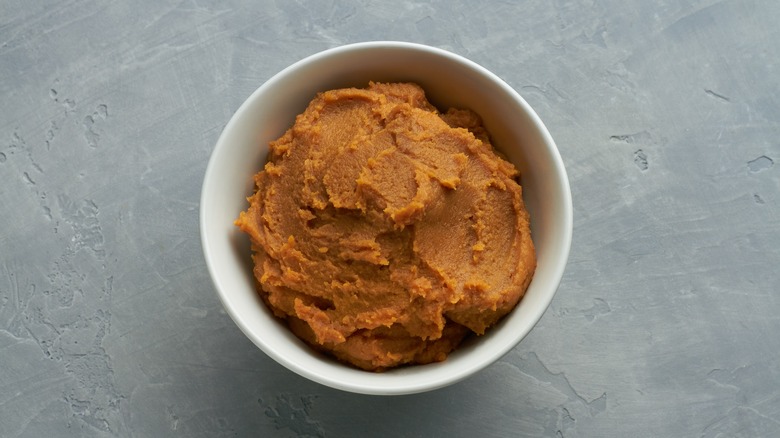The Simple Addition For Upgrading Béarnaise Sauce
If you're like many new home cooks, you might be wondering: What actually is béarnaise sauce? (Or "Quelle est la sauce béarnaise?" if you parler français). Per the New York Times, béarnaise sauce is a creamy variation of French-mother sauce Hollandaise and comparable to a "loose mayonnaise." Although the sauce takes its name from Béarn, France, it was actually created closer to Paris. The pale yellow sauce with green spots of fresh, ground herbs is believed to have been invented by French chef Jean-Louis-François Collinet at his Paris-adjacent restaurant, Le Pavillon Henri IV, which opened in 1836, via Fine Dining Lovers.
Sounds fancy? Despite its elegant name, béarnaise is made from a simple combination of emulsified butter, wine vinegar, egg yolk, and tarragon. Béarnaise is stirred and simmered lightly on the stovetop, similar to making a bechamel. It's commonly served atop grilled meats, especially steak and fish, says Caraway Home, but it can also add a luxurious flair to cooked veggies.
If you want to give the sauce a try for yourself (or, if you're a longtime fan in need of a change) here's the simple addition for taking your béarnaise to the next level — and it might surprise you.
Make haste and add the paste
French cuisine, meet a staple Japanese ingredient. That's right: We're talking about miso. Miso is a paste made from salt, water, and fermented soybeans called "koji," per MasterClass. It isn't just for ramen or miso soup, either. Miso functions well as a rub for chicken or for thickening sauces, says Huffpost. It can even be used as a substitute for chicken broth.
But why does it work for your béarnaise sauce? Umami is famously tough to describe, but it's been lauded as the "fifth taste" — savory or meaty, per Insider. In fact, the word "umami" itself translates to "pleasant savory flavor" in Japanese. (Technically, it's caused by a natural compound called glutamic acid, but that doesn't sound quite as appetizing, does it?) Although there are different types of miso with varying strengths, they all boast a salty umami flavor and that characteristic "fermented" taste kombucha and kimchi fans know and love.
When it comes to béarnaise, just a small portion of miso adds a "savory depth" to the mild sauce, says Serious Eats. To fully incorporate miso paste into your béarnaise sauce, the outlet suggests using an immersion blender.

